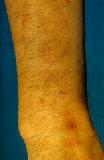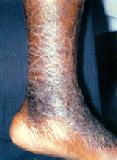The skin is constantly renewing itself. New cells are formed on the lower layer of skin which slowly move upward. By the time they reach the surface of the skin, these cells are dead and are removed daily. With ageing, this process of cell renewal slows down. The "dead cell" layer remains longer on the surface of the skin giving the .skin a dull look. This skin feels rough and scaly.
The supporting structures and elasticity of the skin decreases with age. The skin sags and wrinkles appear.

Fig.1 Senile purpura

Fig.2 Asteatotic eczema
a. Senile purpura Fig.1
The skin of an aged person is thinner and easily disrupted. Blood vessels, too, are easily disrupted, resulting in bruises called senile purpura. Senile purpura is commonly seen on the forearms. Its presence does not indicate vitamin deficiency or a bleeding disorder. The skin heals slowly following injury.
b. Xerosis /Asteatotic Eczema Fig.2
The skin becomes dry and flakes easily as the oil contents of skin decreases with age. Dry skin becomes itchy. Sensations of dryness and tautness are common.
Dry skin has a rough and finely flaking or scaly surface. These are seen in the upper back and the limbs, especially the shins. Sometimes asteatotic eczema occurs in areas of dry skin. These are seen as poorly demarcated, scaly round red patches. Sometimes a distinctive appearance of red scaly fissures in an irregular netlike pattern resembling cracked porcelain is seen.